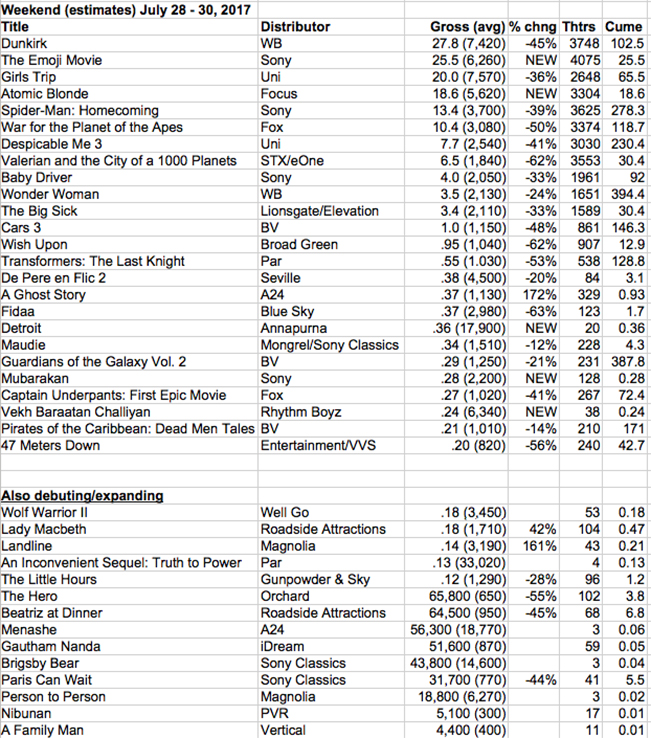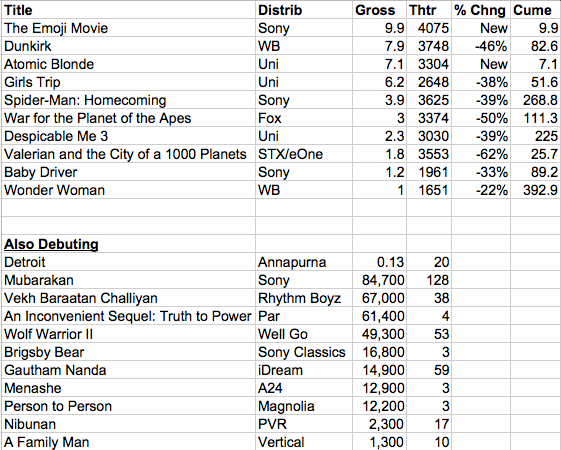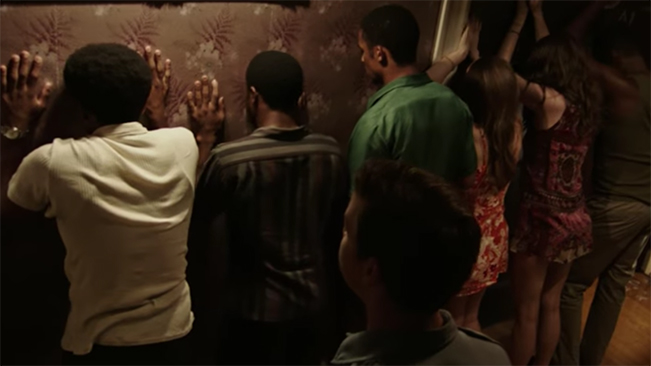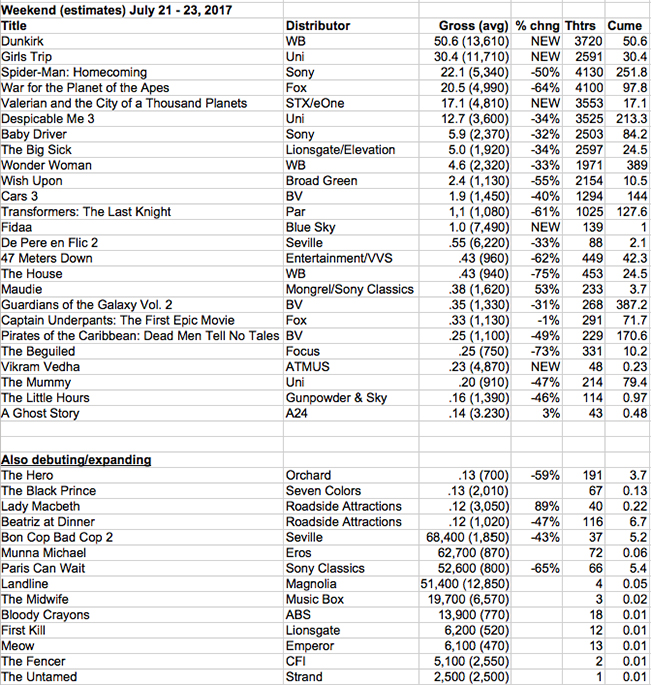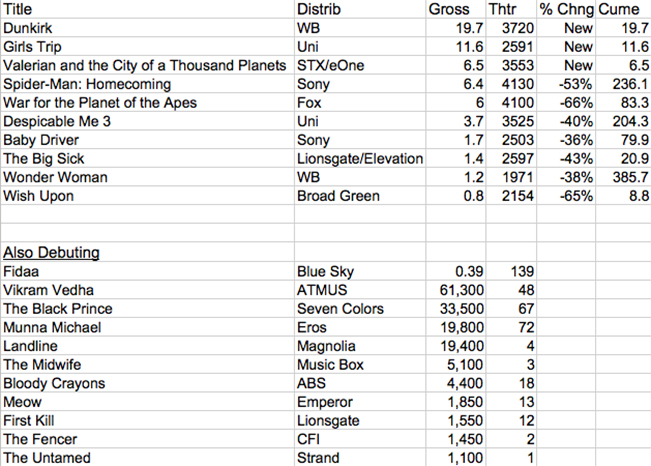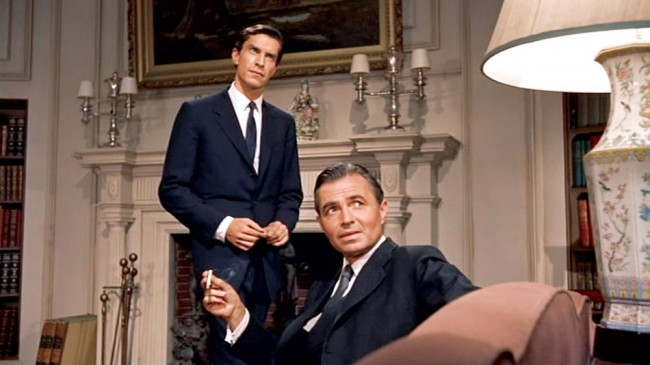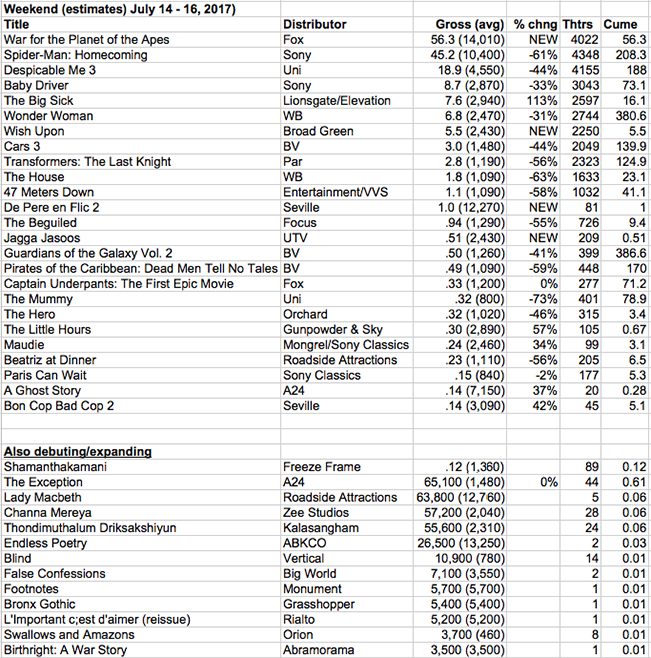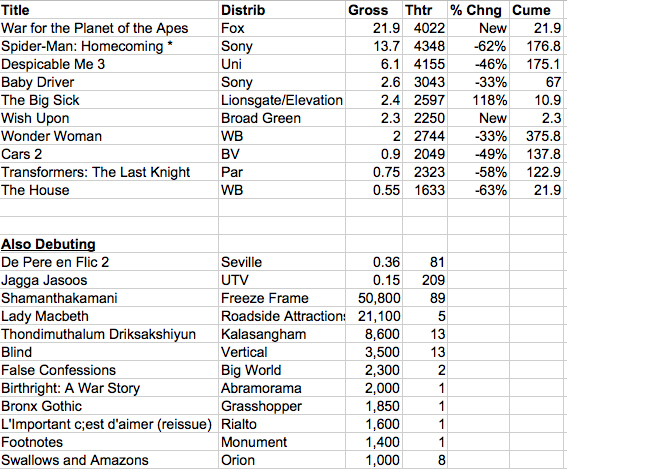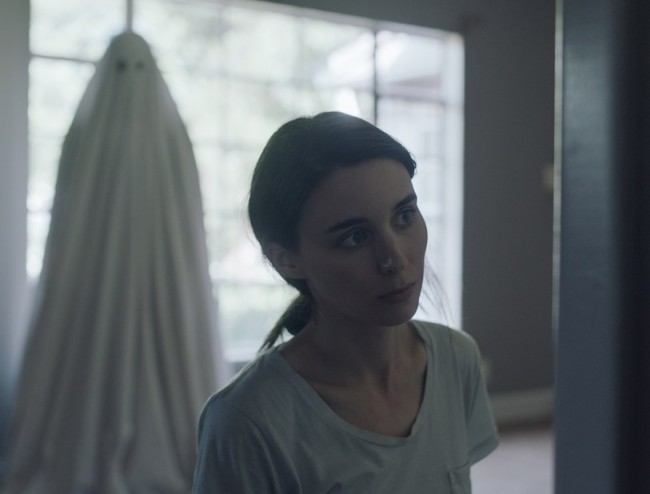The Hot Blog Archive for July, 2017
Weekend Estimates by Sad Face Happy Critic Face Klady
We come not to bury The Emoji Movie, but to remind that a $25m start isn’t so bad for a Sony Animation movie. In this, the worst summer for animation in many years, neither film managed to do 3x Friday for their opening weekend and Emoji, like it or not, opened behind only the Hotel Transylvanias (Dracula & Friends), Angry Birds, Sausage Party, and the Cloudy films on opening, making it the top non-R-rated, original launch by Sony Animation. In perspective, it is a successful launch. Dunkirk wins the weekend by default with a good hold. Girls Trip, Spider-Man: Homecoming, and Wonder Woman all have great holds. Atomic Blonde can’t get to $20 million, but out-opened the first John Wick.
Okay… so Dunkirk takes the weekend because Emoji comes up short. Survival. Ironic.
A 45% drop off opening weekend is solid, though The Martian (which opened to $54m), dropped just 32%. And in NolanLand, both Inception and Interstellar held better. I have ZERO proof, but my intuition on this is that the “See It In 70mm/IMAX” of it all puts up a roadblock for some of the audience that doesn’t want to spend the extra money or doesn’t have ready access to those formats and doesn’t want to see an “inferior” showing of the film.
So what happened to Emoji? Nothing, really. Nearly universally despised by critics, the movie still opened well by Sony Animation standards. It nearly doubled the launch of Smurfs: The Lost Village back in April. Emoji is likely to get to $75 million and could get to $100 million. And Sony has made sequels to a number of films that have done less business, albeit mostly direct to DVD. What would really be scary is if this film somehow blows up internationally, where they are years ahead of the US on the emoji love.
Atomic Blonde was the other new wide release this weekend and it… arrived. As noted yesterday, it opened better than John Wick and not as well as John Wick 2. But with the muscle of Universal marketing leaning into this one, it’s got to be seen as a disappointment. The estimate for the weekend seems to intentionally put the opening just past the 2 bottom openers for Universal this year so it’s not on the bottom. This would be a strong opening for a Lionsgate movie (they released Wick). But not for U. How the media treats a launch that is almost the same as The Great Wall… we’ll see. This opening is not a problem for Charlize Theron, who was the entire sell of this movie and she showed she is still a $10-million-a-film level opening star. But that her much-touted nipples on ice couldn’t come close to the girl power vacation of Girls Trip must be noted. (And my guess is that Ms. Theron’s nipples will play like gangbusters internationally, so make that too.)
Speaking of Girls Trip, it outgrossed Blonde domestically in its second weekend. This one could have legs like Latifah and Tiffany Haddish combined.
Detroit arrives early, as Annapurna launches as a distributor and breaks the rules right out of the gate. What the 20-screen launch says to me is that they are flexible, which is great, but that the film must need the word-of-mouth help, which is unfortunate. I keep hearing that people are afraid of experiencing the movie. And in the most simplistic way, they should be. The movie is tough. But it is deep and rich if you are open to self-reflection. A $17,900 per-screen is pretty good. Not life-changing. But it does mean that 30,000+ people are out there talking to their friends and family about the film. Next week, we will see if it helped. (In my view, the Atomic Blonde open would be a legit success for Detroit.)
An Inconvenient Sequel is the per-screen leader of the weekend, with $33k on four. The opening is about half of the original, which isn’t bad at all, considering much less media attention to this film.
Also strong in per-screen is A24’s Yiddish-language Hasidic drama, Menashe, with almost $19k per on three.
12 Comments »Friday Estimates by The Klady Emoji
I haven’t even seen it and I hate it. Of course, I love Sony Animation, and somehow, my 7-year-old has a big stuffed poop on his bed, next to other characters that help him quiet down at night. (Thank GOD that this is the only poop in that bed for a number of years.) As one of the smaller operations in the game, Sony Animation pushes in less conventional directions and we should be applauding them. Seriously.
The reason we all seem to be happy to hate The Emoji Movie, even sight unseen, is that we all also knew it would be #1 at the box office whenever it opened. That’s also why they made it. It is truly “high concept,” led by a frozen yogurt-looking pile of excrement speaking the Queen’s English. Is there any better metaphor for why some people think the worst of “Hollywood”?
I wouldn’t be surprised if TEM comes close to $40m for the weekend. I keep hearing parents feeling compelled to go this weekend because the kids insist that Poop is the new Wonder Woman.
Dunkirk is holding as well as one might expect. In NolanLand, it’s another success, but it is tracking closely with Interstellar, but without Thanksgiving coming to give it a Week 4 boost. $150 million domestic seems what’s likely, which, as noted before, would be a big success in WB’s eyes. There were real fears that it would not come close close to that number.
Atomic Blonde opens dead in the middle between John Wick and John Wick 2. No doubt, Team Universal would have liked to have started with JW2, which still “only” did $92 million domestic. But… what can you do? That would have made AB a major outlier in the niche. Also, with Charlize, there will be serious hopes for a much stronger international with this film than with the Wicks. This is the first of three movies that are close variations, with Fox’s Proud Mary and the John Wick Spin-off, Ballerina, which could land in the same release window as Atomic Blonde 2: Blonder (plot preview… Lorraine goes to Grenada).
Girls Trip holds well. I’ve seen it now and a big piece of this puzzle is that the women are over 30. There will, clearly, be a Girls Trip 2. But it’s no joke that there should be a Latina Girls Trip and an Asian Girls Trip as well. It is not the greatest filmmaking. But you laugh. A lot. And I am not sure that I would have expected to laugh a women peeing on a crowd… but I didn’t know that Melissa McCarthy’s mishandling her diarrhea would earn an Oscar nomination. Each ethnic group would bring a different spice, uniquely funny, while it could also touch the heart of a longterm friendships. If other studios don’t have these in aggressive development – like set a shoot date and start casting before you have a script – they are nuts. Girls Trip feels… relaxed. And that would have to be appealing to a lot of actresses who don’t want to play off their sex appeal, but are up for real fun. Sofía Vergara, Eva Langoria, Michelle Rodriguez and Paz Vega out partying is a movie.
By the way, the true prequel to Girls Trip was the ads that Ava Duvernay directed with black female stars hanging out listening to music. And another version of this that could be huge would be (development title) Oscar Girls Trip. Imagine Amy Adams, Jennifer Lawrence, Emily Blunt and Emma Stone going on a vacation and drinking a lot of Mezcal. Would have to be directed by a not-great director… any time someone in the film starts to ACT, they need another shot and a character humiliation. And don’t forget the Indie Girls Trip with Zoe Kazan, Jenny Slate, Elizabeth Olsen, and Greta Gerwig.
Detroit arrived to a good, if not sensational reception. Opening weekend will be near 20k per screen on 20. This can go one of two ways. It can allow sampling that creates word of mouth that supports the expansion… or it can die of “It was really powerful, but I can’t ever get through that movie again” word of mouth. Zero Dark Thirty is really the exception in Kathryn Bigelow’s commercial career (and that film deserved a bigger audience and a Best Picture Oscar). So it wouldn’t be shocking to see this film end up grossing high-teens or twenties domestically and still going on to a barrelful of Oscar nods.
17 Comments »From Criterion, James L. Brooks On LOST IN AMERICA
BYOExpectations
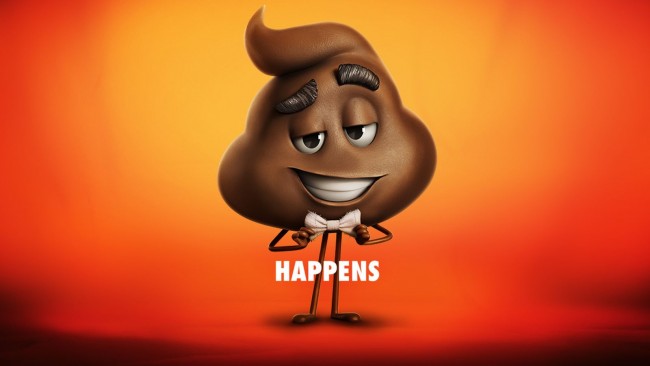 August movies usually stink. But this month there are strong titles, Detroit is followed by at least three that should find diverse audiences: Lucky Logan, Wind River, Good Time, An Inconvenient Sequel. (And yes, Dark Tower.) What movies are going to be good? Could Kidnap be a short, sharp B-movie?
August movies usually stink. But this month there are strong titles, Detroit is followed by at least three that should find diverse audiences: Lucky Logan, Wind River, Good Time, An Inconvenient Sequel. (And yes, Dark Tower.) What movies are going to be good? Could Kidnap be a short, sharp B-movie?
Review: Detroit (no spoilers)

It’s an odd summer. It’s almost impossible to see Detroit after seeing Dunkirk without noticing the very different ways the two films turn the similar trick of reflecting on a huge story by narrowing down to one story, or a few stories that are connected by a single character.
Both films are set in the midst of a war. Yet, the movie set in the non-literal war of race and poverty in the United States is far more violent and painful than the movie set on a beach filled with 300,000 people under the immediate threat of being murdered by the Nazis. And speaking of the real-life villains, Dunkirk never names or shows the Nazis behind the barricades of the town of Dunkirk while Detroit makes the young racist policeman as significant a character in the film as any other… perhaps the lead.
The style of filmmaking couldn’t be any more dissimilar. Kathryn Bigelow delivers a documentary-style production, rough and handheld and sneaking glimpses through doorways and around corners, forever on edge, seeking out, at first, the party, and later, the constant threat that never allows anyone in the film to relax. Christopher Nolan, of course, puts on a master directorial clinic at huge scale, perfectly framed cinematic beauty, even when soldiers are under fire.
Another thing the two films share, though in quite different ways, is that Dunkirk is not really a war film and Detroit is not really a riot film.
Detroit, while steeped deeply in race, is not specifically about race. Obviously, the film takes place at a moment of serious racial stress and division and a white cop is rampaging against black people, in part because he sees them as a lesser form of life. And other people support this evil because of their racism.
But one of the excellent things is that while non-blacks cannot fully feel the black experience of America, anyone can understand and identify with the experience of this group of victims under the control of that small number of law enforcement officers gone rogue. The threat of state authority is alive and unwell in countries all over this planet, enforced against and abused by people of all races, religions, genders and ethnicities.
But primarily, Detroit is a movie about the abuse of police power and how we, then and now, respond to that behavior. There are good white people in this film… and good white policemen. But the true horror of Detroit is how abusive behavior can metastasize into something that gets worse and worse over a short period of time.
Detroit is about Detroit 1967, but it is also about Ferguson. And it is about the Australian woman who was shot through the window of a cruiser by a scared cop after she called in to report a rape. It about people who voted for Trump because they feel their idea of the world is being infringed upon by societal changes. It is about white people who watch or hear racism and say nothing. it is about entitlement and disenfranchisement. It’s Macbeth. It’s The Act of Killing. It touches on the worst of human instincts, primarily the instincts of those with power and the fear of losing that power.
And in some ways, Detroit is the bloody, uncomfortable, demanding, intimate, painful reflection of Dunkirk. In the dozen or so “main” characters of Detroit, you may find yourself and your posture in one or two or almost all of these people. You may – though you can never admit it in public – even identify with some of the positions of the bad cops for a moment (though the next horrible choice they make will likely snap you out of it instantly).
A quick unexpected conversation with another writer had him telling me that I was saying that “he just didn’t get it.” But that isn’t fair. Too simple. His dissatisfaction with the film… his urge for something more (he had specific notes) was sincere. Detroit demands self-reflection. And while some people will not care for it for other reasons, I would guess that a lack of interest in self-reflection will be a big factor for those who dismiss it easily.
Bigelow and regular collaborator Mark Boal lay down about 30 minutes of track before you get to the central story. This is when you may still think this is a movie directly about the July 1967 Detroit riot. Be patient and breathe it in. These events are everything you put in the pan with your Thanksgiving turkey, stuffing and basting juices included, that brings it flavor.
Then you get to the movie… What Happened At The Algiers?
It’s a horrible story. I would suggest you not read anything about it (at this point) before seeing the movie. But you take a city on edge, a bunch of law enforcement groups that are not effectively coordinated, and a bunch of young people who are a bit wild, but who are basically staying away from the trouble of the riots, and a few others, and with the BANG of a starter’s pistol, the hot snowball of rage and fear starts rolling downhill, gathering speed as all the individuals struggle to get out of the way.
I am not going to get into story, because that is your work and pleasure as a moviegoer. But there are many layers to this story of victims, victimizers, collateral damage and the jaded. There is racism, sexism, pacifism that borders on appeasement, opportunism, religion, lust, hate, paranoia, confusion, and so much more.
I haven’t had chance to see Detroit a second time, but my guess is that I won’t really have consumed what this movie offers in a full way until I have seen it three or four times. Often, it is like trying to think about something objectively after being punched in the face. There are so many blows landed that until some of the big painful moments are cataloged in your brain so you aren’t rocked in your seat, moments of this movie will be missing from your experience.
Performances are uniformly excellent. It is truly an ensemble film. Will Poulter would be the lead, if there is one… but you won’t want to think about his character as a lead. Algee Smith is the character that rises out of the ensemble through the film. But there are wonderful turns everywhere you look. There is no celebrity hierarchy. Hannah Murray, who you will recognize from a TV show (I will let you figure out which one), gives a really unexpected turn here as her character charges from one emotion to another. Honestly, the only actor I was unhappy to see was John Krasinski because it is a small-ish part, late in the film, and he feels like more of a celebrity showing up. He does well with it, but unlike other actors, he sticks out.
Detroit is a film of size and substance and I don’t want to commit to it being the best film of the major studio size releases this year to date, but I kinda do. I want to see it again before I go there. Honestly, I don’t know how I will feel the next time. Or the time after that. But I do know that I will feel. And feel deeply. And it will make me think about the world and my place in it and how I see others. This will make some writers very uncomfortable. What more could we ask of a film?
19 Comments »Weekend Estimates by Len Dinghy
Dunkirk‘s opening is soooo Nolan.
I get that it was above expectations. I know that the studio was thinking mid-30s. But with Inception‘s $63m opening and Interstellar‘s $48m opening, you wonder why Nolan didn’t do Inchon.
Wait… no… I’ll go with three’s a trend in this case. No one else has delivered like this with original dramas at a studio level. Yes, they are huge spectacles and that is a big part. But still.. these numbers are consistent and remarkable.
But that is not the only remarkable opening this weekend!
Girls Trip at $30 million is in rarefied comedy company at the box office. It’s not only the biggest comedy opening of this summer and this year—and by a lot—but it’s also a big number for any group of actors who don’t generally open movies in this range.
Oh yeah… and it has four actresses in the leads… and they are black.
I don’t want to get too far into the whys and wherefores about this, because I don’t really know.. nor do many others. We do know that black audiences are committed, in many cases, to show up for black movies. But this number suggests a greater-than-might-have-been-expected white audience for this film, particularly women.
What I do think is that we will see a wave of films like Girl Trip, even though we’ve had an R-rated girl group comedy fail this summer (Rough Night) and three other R-rated comedies flop (Snatched, The House, Baywatch).
Of course, stories like “Why the R-Rated, Raunchy Comedy’s Box Office Partying Days Might Be Over” were always stupid on their face. That is one big lesson of Girls Trip. Media wants every story to double as a trend story. And that is absurd. There will be original hits… and misses. There will be comedies in all kinds of combinations. Dramas will have a glass box office ceiling… until one blows right past it.
The reality of the film industry is that there is a pretty healthy black comedy business. There are not a lot of comedies being made (or films, in general) with female leads of color. We have had moments where that was a trend, most recently around Queen Latifah, who is in Girls Trip. Ideally, this success will create opportunity for everyone involved in this film, though a number of participants have strong, consistent careers.
Valerian and The City of 1000 Planets didn’t do a big opening number. Oddly, it is almost identical to the opening number of The Fifth Element. That film did $200 million overseas. The expanded international box office could double that easily… or not. Look at China as a huge opportunity for this film that has the touch and feel and positivity of Stephen Chow, who is a massive box office hero in China.
Spider-Man: Homecoming is doing okay, but just passed the domestic haul of Amazing Spider-Man (both after 17 days) and is a couple hundred million behind internationally. It might catch up with ASM internationally… but maybe not. Journalists generally like this film. Didn’t like ASM. So…
War For The Planet of the Apes is not going to catch up to its predecessor. Fox tried to play the “big finale” card, but no one seems to have bitten.
Baby Driver and The Big Sick are having nice holds… but they are holds now… no more expansion… but $100m and $40m for these films are big, unexpected successes.
$12,850 per for Landline on 4 screens.
19 Comments »Friday Estimates by Beached Klady
A weirdly reflective Friday at the box office…
The opening for Dunkirk is almost identical to the Wednesday-Thursday-Friday “opening day” of Interstellar. ($19 million)
Valerian and the City of a Thousand Planets opened to almost the same number that The Fifth Element opened to in 1997. ($6.1 million)
And Girls Trip is right around the two-day openings of Baywatch ($10.3m) and Snatched ($11.5m), while blowing away the 3-days of Rough Night and The House on opening day.
What does it mean?
The media will make Dunkirk sound like it beat the world while opening to War For The Planet of the Apes or Cars 3 numbers. Why? Because we like it. And then, in thinkpieces in a few weeks, they will forget that an original opened to over $50 million because it doesn’t fit the “theatrical is dead” mantra.
Interstellar made almost $500 million internationally. The real financial success or failure of Dunkirk will be in that international number, same as every other $150m+ budget film. The artistic success is not related to the commercial success… but when one is emotional, it is hard to separate them.
Valerian? Was always going to be a hard sell domestically. You probably didn’t know that as a director, Besson never had a gross as high as $70 million domestic before Lucy. This one will do, probably, slightly better than The Fifth Element‘s $64 million domestic, but the big leap will come internationally, where it could smash the $200 million international that TFE did, especially if it gets a playdate in China, where it fits right into the favored kind of film… not that violent, not very sexy, big, broad, and fun.
Girls Trip is the #1 comedy of the summer. It is female-driven, although female-driven comedies have been pretty much the only comedies of the summer of 2017, period, exclamation mark. It is based around four black women. Much more rare… and historically, much more likely to have gotten a more location-based release.
This will be the top opening day as stars of a film for everyone in the movie, including Queen Latifah. And it will be read in many ways for months to come. Was it the black audience showing up? Was it a higher percentage of white audience than has been historically expected for a comedy led by black actors? Was it women who don’t really care about race, but do care about the laughs in ads and trailers?
The last Universal comedy that opened this well was Ride Along 2 and the last original comedy that opened this well was Trainwreck, two years ago (which is the film that spurred this summer of female-first comedies). Is Universal a color-blind studio now, with this and Get Out this year?
What is sticking with me is that Disney, the current top dog in the industry, and Universal, the current clear #2, appear to be the major studios that push hardest for diversity in their movies, both on the screen and behind the camera.
While I do believe the international market has serious racial issues that are worse than domestic theatrical, this is the kind of movie that should be pushed hard to break through that. It’s Grown Women Gone Wild and should be marketed as hard, and with similar funding to Magic Mike ($53 million international) and even Sex & The City ($262 million international), although S&TC had the multiple seasons of the show as a big advantage. Scary Movie 5 is the only Malcolm D. Lee movie to do over $4 million internationally. But Ride Along 2 did $33 million overseas. If Girls Trip did over $20 million internationally, it would be an important landmark internationally for distribution of movies starring black actors who are not Denzel or The Rock. And it has a real shot at doing over $100 million domestic.
War for the Planet of the Apes didn’t have a great hold and should be just short of $100 million at the end of the weekend.
Spider-Man is still doing… okay. Hard to say where it will land.
Despicable Me 3, on the other hand, is doing okay here… and should pass $700 million worldwide this weekend.
Wonder Woman should take the domestic summer crown from Guardians of the Galaxy: Vol 2‘s today. But Guardians looks secure as the summer’s worldwide winner.
Baby Driver and The Big Sick are both over the box office hump now. How long can they cruise?
Landline is opening on four to over $10k per screen. Not as well as Obvious Child. But Magnolia is not set up for theatrical first, and A24 is.
52 Comments »Trailering Whoopi Goldberg And Charlie Sheen’s 9/11 for 9/8
Just when American movies were getting good again… Graphic Towers footage, as you would expect.
For clearing the palate immediately after, how about Guillermo del Toro’s The Shape Of Water again?
2 Comments »Review: Dunkirk (spoiler-free)

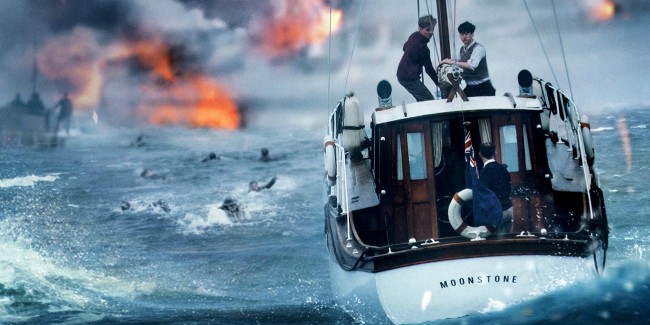 It was the best of films… it was the worst of films…
It was the best of films… it was the worst of films…
Dunkirk is the ultimate film critic Christmas present sitting at the base of the tree on the most beautiful of Christmas mornings with all of the relatives you loved back from the dead (in a nice way) and there to enjoy every moment of your cinematic pleasure.
And… Dunkirk is an overly-refined ticking-clock movie without a clock or any significant insight into the power of what happened on that beach in seven days in May 77 years ago.
How can Dunkirk be both these things?
It takes a genius. And Christopher Nolan is a genius filmmaker. It is impossible to imagine that he won’t, finally, get his first Oscar nomination for directing this… because it as directed a film as you can imagine. The images are big and bold and every frame is a picture of skill and elegance. The IMAX experience is different than the 70mm experience – one feels like uncharted territory and the other just gorgeous – but either way, it is a visual feast.
It also takes the myopia of genius to make a movie about 300,000 people, reduce it to 12 of them and not worry about the scale of the human experience. I am not unaware of or unsympathetic to the idea of reducing something of massive scale down to a handful of people who stand as symbols. And Dunkirk tips its hat to that… but only kinda. It’s a movie that shows you massive numbers of men in landscape view, rarely harking back to massiveness of the effort… never even suggesting for a moment that 700 small boats came to the rescue. (I would estimate that the largest group of boats we saw numbered 20 or less.) And in a movie so full of starkness and imagery, you may be too busy to notice that you are being Forrest Gump-ed by the lead character.
By the end of the movie, a character has to tell us what was meant to happen on that beach and what actually happened on that beach or we would not know. (And don’t even get me started on the failure to explain what “The Mole” is until late in the film and then only in passing. It’s the pier.)
There is nothing inherently wrong with the film focusing on a young grunt trying to survive the week. But handsome as he is – and this is a movie of handsome men – he is a blank canvas that Nolan uses to tour the audience through a variety of stories that I assume really happened to someone on that beach. The audience never knows what our protagonist knows or even what he wants, aside from survival.
The problem with that is that even though the movie is a beautiful book of images from that period, meticulously and magically brought to life, I don’t know what Christopher Nolan feels about this whole enterprise. The film is not devoid of feelings or comment. Almost all of the emotion there is comes from Mark Rylance’s character, whose motives and ideas of the world become clear.
There is a major point about/in the film that is also a major spoiler, so I will hold off for now. But I do feel like this event and the meaning behind it for Nolan is a major part of the conversation about this movie. It has to be deliberate choice by Nolan to make it so singular an event in a film in which death in around every corner. But… later.
The movie comprises three distinct parts; Land, Air, and Sea, each of which has characters associated with it and through all of which the lead character wanders. Branagh is mostly there to look stoic and to be Basil Exposition. Hardy is one of two pilots who are fully committed to doing all they can do to protect the men hoping to escape the beach. (His mumbling covered by a mask seems almost like self-homage at points.) And there is Rylance, who captains one of the private ships and has a teen son and a teen family friend on board. The Rylance segment is where almost all the emotion – aside from being threatened by bullets, fire, or drowning – exists in this film. And there is the central character, the silent thread, that someone manages to have every possible experience of The Dunkirk Miracle in two days.
I recommend that anyone who loves movies see Dunkirk and if you can find a way to see it in IMAX, spend the time and money to do that. You should have this experience. And you should take from it what you instinctively take. Don’t listen to critics, pro or con. Just go have the experience.
That said, Dunkirk falls well short of a masterpiece because I was watching a filmmaker do something beautiful, but I was not filled with the spirit of Dunkirk. In a very intensive 106 minutes, I think I got hit emotionally four or five times. None of it sustained.
Near the end of a second viewing, I was struck with a comparison to Chariots of Fire, of all things. In that film, Hugh Hudson balanced the dryness of the British temperament with deep passions of two runners, one who ran for respect and the other who ran for God. I later thought about how unique the imagery of the track racing was at the time, and even how the Vangelis score (which became a cliché in an instant) was unique at that time. Among the things that makes Chariots work better than Dunkirk for me, is the emotion the lies in the choices that confront both runners and moments of insight and emotion like Sam Mussabini punching through his hat, alone in a room where he is hiding, when he finds out his charge has won. One of the few memorable emotional beats in Dunkirk is a simple line from an old man who understands better than young men what is of value. Not quite grand emotion… but the closest to even subtle celebration we will get here.
Still, only the Rylance character (and for a moment, his son) gets to confront morality in a real way in the film. (There is a moment with the boys that comes close, but circumstance keeps morality from being resolved in a real way.)
I can’t agree with many critics that this is a great war film. It’s not really about war. It is about one element of war, commitment. The war and those 299,888 men are really a backdrop. No one is making choices about this war and their role in it, except at the most micro level. Even when choices come up, the die is really cast.
All the great war films are steeped in choice, often from the first frame to the last. And indeed, the most emotional moment of the film surrounds the rare character who makes a choice of a sweet whim and suffers from fate, not war.
Dunkirk also puts me in mind of The Revenant, which I had very different issues with, but which was also a remarkable piece of filmmaking. My issues with the movie aside, Iñárritu devoted a lot of the film to the deep emotional drives of those characters.
Less of Dunkirk would have served the movie’s ambitions better. The movie is tightly cut… not what I am saying. I don’t agree with Todd McCarthy’s conclusion, but “Dunkirk is an impressionist masterpiece” is right on line with the truth. It’s an impressionist piece. So the concessions it makes to traditional filmmaking don’t serve that well. I would prefer a 100% commitment to impressionism. Of course, the financing might go away. So I get why the film swings back and forth between pure, you-figure-it-out-audience art and a Movie. As a reslut, I was left surprisingly hungry leaving the theater.
I had no expectations walking into the theater. And seeing it a second time disabused me of any notions that might lingered. I am happy Christopher Nolan got to make the film he wanted to make. I am glad Dunkirk exists. But I don’t think much of it will stick, outside of cinema studies class and great moving image packages. I still want to see it again in IMAX. It is absolutely beautiful. I can’t say often enough, do go.
It’s just… I wanted to walk out of Dunkirk with my heart beating. And I walked out with my brain humming. Frustrating for me. Not for everyone.
25 Comments »Weekend Estimates by War For The Box Office Klady
Apes: Volume 2 – Episode 3, as described yesterday, followed the pattern of a new box office niche. Establish a decent-sized domestic audience, maintain that audience, never grow much past that audience. Some of these audiences are bigger, obviously. Harry Potter, Twilight, and Rings all lived up in the $300 million neighborhood domestically before adding big international numbers. Then you have series like Divergent and Percy Jackson that are of a lower order. In the middle, Apes.
One of the new tricks attempt an uptick in stable franchises is to create a closer for the series. This trick has been connected, in the upper echelons, to the two-part closer, which is riskier now (though even with a downtick, the 50 Shades franchise seems sure to make a profit even on its third film).
So perhaps this is what Fox was thinking when it pushed the “This is the END” agenda on Apes 3: War.
Didn’t work.
At the risk of a spoiler, I would have suggested a pivot to the new idea out there, the franchise makeover. Ground the franchise to the series, but change the crew and the tone to get the next wave. This film could have been sold as “Apes: The Caesar Saga – The Finale.” I don’t think it would significantly changed the profile of this movie financially (or to shorten… wouldn’t have worked). But I do want to see the kinda-sorta-remake of Planet of the Apes that is the natural next step, unless they want to do a very political, chatty, human-free version of The Founding Of Ape-merica.
The industry is still figuring out how to effectively manage IP, while being distracted with the details of each individual film and its financial profile. The same is true of Netflix and content, though we are even earlier in the maturity of on-demand subscription based future… though the individual project distraction is cloaked by financial and result secrecy.
Marvel (shocker!) has the most success in building off center-brand, then bringing side brands into the big brand. One of the tools they are big on now is adding center-brand characters to slightly-off-brand movies as secondary leads. Hulk in the upcoming Thor. Iron Man in Spider-Man. Iron Man and then Ant-Man and Spider-Man in the third Captain America. Of course, most franchise plays don’t have this kind of range of characters to work with.
We have found, with two films, that off-center Star Wars films make management nervous.
Warner Bros has had a great success with its first non-Bat/Supes off-shoot, which followed the Marvel history closely, as Wonder Woman mirrors the first Captain America closely. At the same time, as they work to roll out individual JLA characters, they will be coming off the the JLA film, not the other way around, as Marvel has done.
There is a lot of talk about Tom Rothman doing a bunch of cheap superhero movies at Sony, spun off the Spider-Man rights. Anyone who is in this business should be applauding this move, as it could be a working model for others. And if it fails, only Tom gets hurt. Why would you care? Ideally, the cheaper model would allow for more aesthetic freedom and more interesting director choices.
One has to wonder what the meetings are like at Fox, where they have the X-Men and Fantastic Four in line for reboots and Deadpool all blown up. There really needs to be a 5-year-plan and a $2 billion commitment (inc P&A) to at least 7 films in this mini-universe and that should bring on IBS for any executive who is determining their heroism or death by 7 severe cuts in greenlighting it all. Worst/Best of all, the right choice is to create their own signature angle on this, not to just imitate what Marvel once did… because Marvel has already made those adjustments.
Would you pay to see a movie in which Wolverine, The Thing, Deadpool, Storm, Sabertooth, Mystique, and The Human Torch do a Magnificent Seven, directed by James Mangold? I sure would.
What would a romcom with Reed Richards courting Sue Storm look like?
What would an Alien movie look like with earth-bond superheroes, who can’t breathe in space, be, sharp claws and laser eyes on the Nostromo being a problem?
Obviously, there are thousands of variations. This is the experience of being a comic book fan. (At least it was for me.) Virtually anything was possible in any new run of books.
Hell, they could do their own Civil War and kill almost every Marvel character they control… then restart again. There is a small part of the ticket-buying world that cares about The Universe. Most of them want to see that really cool thing that the trailer showed them. And then the next one. Then the next one.
So… War for the Planet of the Apes did okay. The number wasn’t shocking in either direction. And now, we wait to see if international is stronger or weaker than the last time.
Spider-Man: Homecoming, off 61%… not so good. 50% is about the optimal number on a big Marvel opening. The film is still ahead of Wonder Woman‘s clip at 10 days, but that should flip (putting WW ahead permanently) this next week. Still, the celebration of one film’s gross and the diminishment of the other isn’t about the math. Both films are amongst 46 in film history to crack $200 million in 10 days or less. For the record, this “homecoming” is just over $60m ahead of Amazing Spidey 2 after 10 days. International, which was laid out rather oddly in comparison on ASM2, feels like it is running about the same, which is to say, pointed towards $500m+, but not $700m.
Some readers of this space seem to want a full paragraph Wonder Woman shout-out every week… a testimonial to the film’s success. Another great hold. And it should pass Guardians Vol. 2 for top summer slot next weekend. Wonder Woman has certainly become the best liked large-scale movie of this summer.
Also holding strong, on a whole different scale, is Baby Driver. Did anyone really expect Baby Driver, with no opening star, to be at $73 million domestic in 19 days? That’s $8 million behind Passengers, which had the Christmas week advantage. It’s $37 million behind Ghostbusters, which is Sony’s #1 domestic non-Spidey grosser of the last 2 years, but the two films at the 19-day mark are heading in opposite box office directions. Could Baby Driver pass that $128m domestic landmark? It would be a huge stretch, finding part of the audience that hasn’t landed yet.
Coming in a couple weeks, in a similar vein, Atomic Blonde is coming and big Universal has taken over much of the marketing/publicity of the film from Focus, apparently in the effort to mine the opportunity on the studio scale. It’s interesting to wonder whether Baby Driver‘s success increased fire under this title. The film doesn’t have the Rotten Tomato 100% advantage that Baby Driver had and which Sony worked hard (though they claim otherwise). But it’s one of those odd cases where 4 “rotten” reviews are killing their number (currently 78%). Variety reviewed out of SXSW and I would expect Universal to be pushing for a re-review by Debruge. The other three are Erik Childress (for The Playlist), William Bibbiani (for Crave Online), and Meredith Borders (for Birth.Death.Movies.). Nothing against those individuals, but the madness of the whole obsession with RT scores is exposed when you see the ability for a campaign to be derailed (U will work around it, obviously) by a few website freelancers. Big Comic-Con push this next weekend with a branded (funded?) EW Hall H appearance by Charlize.
Despicable Me 3 has “only” done $187 million in 17 days. That’s well off of DM2. No one is crying. That’s because of $431 million international. That’s #3 for the summer so far. No one is crying for the #1 international grosser of the summer to date either… Pirates 5… $750 million and counting. Boo hoo.
Wish Upon is actually Broad Green’s #3 opener ever. But that doesn’t make it good. The film is destined to gross its reported $12m production budget domestically. (Which means they get half back before paying for marketing.)
The Big Sick is another happy box office story. As noted yesterday, the expansion is a solid double, not a home run… mostly meaning that these numbers don’t scream that there is another gear up, just nice holds as it plays theatrically through August. Nothing at all to be unhappy about. The film is well on the way to being profitable for Amazon and the 30s or 40s are ahead.
Speaking of big per-screen, De Pere en Flic 2… ya feelin’ me? And in English, Lady Macbeth and Endless Poetry.
67 Comments »Friday Estimates by Primate Klady
Déjà monkey.
War for the Planet of the Apes is a perfect example of a pretty new classic… the franchise that does well enough at home to keep going, but grows internationally to make it worth continuing. This is, thankfully, the well-reviewed version of this phenomenon. I am glad we have these films and Matt Reeves has delivered another strong episode, albeit one in so small a world space that it doesn’t feel like a wrap-up to the series at all.
The first two films in the new series did $177m and $209m respectively domestically. (If you are whining about this opening, you are a box office ignoramus.) The second of the two, Dawn, did $502 million internationally, compared to $301m for Rise. If the franchise grow internationally again, expect not only a #4, but a #5.
If they continue, it appears that this film is meant to be the end of the Caesar era. If there is a #4, I would expect it to push a generation into the future, to just before the Charlton Heston version, when the people who are left have been turned into what apes once were. But is Caesar himself the Robert Downey, Jr. Iron Man of this series? These three films have been unique in their willingness to kill off cast and move along without worrying about giving the audience familiar humans in multiple films. Would the next be an entirely new start? Is that the answer to IP in 2017?
Not a definitive day for Spider-Man: Homecoming. It’s running ahead of Wonder Woman. Weekdays were strong. But it is off the number for the second Friday. The weekend will tell more. $400m+ worldwide is for sure this weekend, but $450m is possible.
Baby Driver is still revving its engines, heading past $70 million domestic this weekend, already Edgar Wright’s biggest film worldwide.
The Big Sick goes wide – 2597 screens – and does well. It is significant that Lionsgate (and Amazon Studios) are taking a very different tack than last year with Best Picture nominees Hell or High Water or Hacksaw Ridge or Manchester by the Sea (Amazon via Roadside). Hacksaw started wide and neither Hell or Manchester ever got to a screen count like the 2597 of Sick this weekend.
The closest thing comp in the last couple of years is St Vincent, a couple years ago, with Bill Murray and Melissa McCarthy. They went wide in the third weekend, while this is Sick‘s fifty. They had a $7.7m weekend, which Sick won’t likely reach this weekend, but close. But they held well and had seven $1m weekends before starting to fall off with over $40 million in the bank. $40 million would be a big number for a Kumail Nanjiani dramedy.
Take a look a Box Office Mojo’s respect for Kumail’s box office power…

You can’t fault Lionsgate and Amazon for hitting the gas here. The ambition to get well past $20 million is honorable and word-of-mouth suggests that passing $30 million is not a pipe dream. And $40 million would not be a miracle… just magical.
Wish Upon is a niche release with a even nichier opening.
Lady Macbeth is the arthouse hero of the weekend, with over $11k per screen for the 3-day.
46 Comments »BYOSheet
Scary stuff! Talk about A Ghost Story (mark spoilers where necessary)? There’s both hate and love out there for David Lowery’s life-looping melancholy.
What have you seen in the past year that rattled the windows, whether new or something you’ve watched for the first time? (Not including the 3pm, 5pm, 7pm and 10pm headline news drops.)
The Wailing? It Comes At Night? The Bad Batch? And is there such a thing as Post-Horror?
43 Comments »Really Simple Perspective On The Film Business (Summer 2017)

We are at that time of the year when there isn’t a lot of news… so otherwise professional people start mouthing off like a bunch of nattering nabobs of negativity.
In 20 years of doing this, I have had maybe four or five years total in which I didn’t hear “It’s worse than it’s ever been!” Hollywood is always shutting down. It’s always over for theatrical. The Next Big Thing is forever running this town.
Then it shifts.
So on this sunny mid-July morning, let’s look at some numbers… really, really simplified, stupidly simplified numbers. And then, you can make up your mind.
Worldwide Theatrical for US studio-based movies
$30 billion.
Returns on those grosses to the distributor
$15 billion.
Post-Theatrical Revenues for US studio-based movies (no licensing)
$14 billion
Returns on those grosses to the distributor
$9 billion
So… for all the effort of releasing movies into the world, US studios are looking at a big pot of about $24 billion a year.
$8.5 billion into production
$7.5 billion into marketing
Again, super broad-figures, but that leaves $9 billion for overhead and profit.
Netflix is a most excellent company and has been a boon to the studios, even after they stopped spending on licensing already-released theatrical films for streaming.
How much is Netflix spending each year on what they categorize as films? About $500 million.
And Amazon, which does theatricals? About $350 million.
Absolutely no disrespect to either streamer… but they are the tail, not the dog. They are not close to the size of any major, in terms of output. They are close to – and Amazon is often in business with – Lionsgate… but without the library value Lionsgate has.
But media is again caught up in the charming fantasy of change. There is no denying that Netflix, in particular, has been a pioneer and change-maker. They have shifted – first with DVD rentals, then with streaming – the preferences of the end user. Streaming, which was inevitable, is happening at least a decade before slow-moving studios were ready to make the switch. That is Netflix’s first mover advantage.
The idea, however, that the entire film industry needs to change what it is doing to accommodate Netflix throwing $275 million at Scorsese, Pitt, and Will Smith is, simply, insane.
The question of how to expand revenues again after DVD crashed – in part because of Netflix and streaming, but in part because of greed and short-sightedness in the management of the format – is completely legitimate. But studios have to remember where their money is. Most of it is tied up in theatrical and the too-expensive marketing push to break new product into the market.
Perhaps a good moment to bring up China. Huge new market. Could become as big as the U. S. and Canada for the majors. But right now, it’s worth about 14% of the domestic market. Roughly $2.7 billion a year in grosses for U.S. movies, but with half the return (or worse) as other international markets.
Yet, in the last few years, we have all seen a gold rush attitude toward China, as well as the massively expanded international market overall. And that has changed the way films are chosen and made.
Look back at 2006. There were 100 films that grossed $50 million or more worldwide. 49.7% of the gross was international. Last year, 102 films grossed $50 million or more worldwide. 59.5% of the gross was international. That 10% change, in a low-margin business, changes everything. If we were still seeing the DVD revenues of that mid-2000s moment, you would be seeing star salaries in the $40m range for at least 10 actors and $400 million production budgets. And we’d have the same complaints, but there would be so much cash, everyone would be dumb & (metaphorically) fat.
Ten years further back… 1996. Pre-DVD. Only 38 films grossed $50 million or more worldwide that year. And 53.7% of the grosses were coming from international.
Netflix is not an unimportant factor. China is not an unimportant factor. But the industry, settling in to the horror of having lost the Home Entertainment business as it was, is endlessly searching for the Next Big Thing.
Bob Iger, after two previous attempts at resetting the Disney business, found gold in Big IP. Twenty years from now, we will no doubt be discussing how Disney fell apart under the weight of that Big IP machine. But for now, it is the platinum standard. It has worked because of the IP itself, no half-hearted buys. And it has worked because o fLasseter and Feige and Kathleen Kennedy. And it has worked at least in part by the rise of CG as an expensive, yet reliable storytelling tool.
1978, You will believe a man can fly. 2002, You will believe a teen can swing through the streets of New York. 2006, You will believe that you are seeing an actor acting with his face covered by a digital squid. 2011, You will believe a Transformer can act.
Now… here is the big problem. The future of post-theatrical is not going to get richer. It will grow incrementally over time. And there will be breakthroughs in countries like China, in which the massive population will pay $2 US a month for channels like Netflix and even though it is frustratingly cheap, it could mean a $4 billion a year (or $2 billion or $8 billion) bump for those companies who intend to make that happen.
But aside from the obvious, and the long future hopes… the post-theatrical market is static. Since studios are not building their own Netflixes effectively, not only are they losing a lot of short-window revenue, but their libraries – even fairly recent ones – are relatively fallow.
“Doing Disney” is just not an option for anyone else. Universal has done, by far, the best job of finding middle ground, even with the disastrous Mummy launch this summer. They build on what they have. They try to make thoughtful additions (Amblin, DreamWorks Animation), but they aren’t breaking the bank to chase the IP monster. Universal is minding their knitting on lower-budget and mid-budget movies that deliver for them.
And the truth of the future is, again, that it can become stable… but it is unlikely to provide significant growth. A hundred million households in the US will only grow in number incrementally and the $90 or so the average household spends on having entertainment piped into the house can only grow incrementally.
ESPN is the current big victim of the new reality. When cable/satellite became the norm, ESPN was a must-carry. In 2017, the idea of must-carry is at death’s door. A couple years ago, in a system built across two decades, ESPN was in more than 100 million households and had gross revenue from that alone of $6.9 billion. Fastforward to the coming future. say 20 million households “need” ESPN. Say they charge $15 a month and get it. That’s $3.6 billion. And that would be a massive (unrealistic) success in the coming future.
Disney, as a unit, can, I believe, get 98% household saturation in the future. But not for a single arm of Disney. For all of Disney’s post-first-release product, including ESPN, ABC, etc., that’s only $18 billion a year. And there will be room only for seven or so such $15-a-month entities.
We are really early in this process. But I believe it to be inevitable. Digital walls are too thin. They must be rebuilt into the next standard, which can then survive the next 50 years
That is why theatrical release — the one true one-ticket-per-customer opportunity for film moving forward — will become the dominant focus for growth. Not because I love the church of cinema (and I do), but because of money… greed… human nature.
If studios can’t go back, and they won’t invest deeply in going forward, what choice do they have? You could try to prune and increase the yield. Thus, the suicidal idea of day-n-date, for which Premium VOD is a Trojan horse.
If reading all this makes your head hurt, go back to the big, oversimplified numbers at the top of the piece. If the concept of the scale of the industry vs the endlessly hyped “agents of change” concept, the one that the media is forever in love with, but refuses to do the math on, is the only fact you take away, it was worth the effort.
8 Comments »




